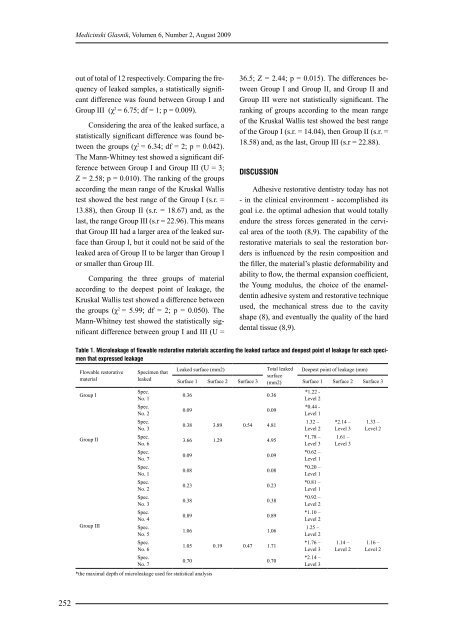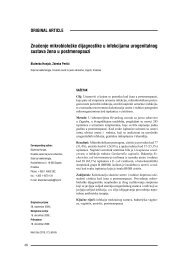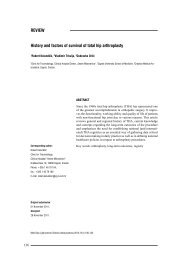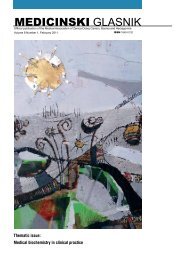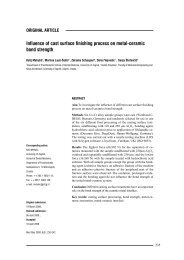MEDICINSKI GLASNIK
MEDICINSKI GLASNIK
MEDICINSKI GLASNIK
Create successful ePaper yourself
Turn your PDF publications into a flip-book with our unique Google optimized e-Paper software.
252<br />
Medicinski Glasnik, Volumen 6, Number 2, August 2009<br />
out of total of 12 respectively. Comparing the frequency<br />
of leaked samples, a statistically significant<br />
difference was found between Group I and<br />
Group III (χ 2 = 6.75; df = 1; p = 0.009).<br />
Considering the area of the leaked surface, a<br />
statistically significant difference was found between<br />
the groups (χ 2 = 6.34; df = 2; p = 0.042).<br />
The Mann-Whitney test showed a significant difference<br />
between Group I and Group III (U = 3;<br />
Z = 2.58; p = 0.010). The ranking of the groups<br />
according the mean range of the Kruskal Wallis<br />
test showed the best range of the Group I (s.r. =<br />
13.88), then Group II (s.r. = 18.67) and, as the<br />
last, the range Group III (s.r = 22.96). This means<br />
that Group III had a larger area of the leaked surface<br />
than Group I, but it could not be said of the<br />
leaked area of Group II to be larger than Group I<br />
or smaller than Group III.<br />
Comparing the three groups of material<br />
according to the deepest point of leakage, the<br />
Kruskal Wallis test showed a difference between<br />
the groups (χ 2 = 5.99; df = 2; p = 0.050). The<br />
Mann-Whitney test showed the statistically significant<br />
difference between group I and III (U =<br />
36.5; Z = 2.44; p = 0.015). The differences between<br />
Group I and Group II, and Group II and<br />
Group III were not statistically significant. The<br />
ranking of groups according to the mean range<br />
of the Kruskal Wallis test showed the best range<br />
of the Group I (s.r. = 14.04), then Group II (s.r. =<br />
18.58) and, as the last, Group III (s.r = 22.88).<br />
DISCUSSION<br />
Adhesive restorative dentistry today has not<br />
- in the clinical environment - accomplished its<br />
goal i.e. the optimal adhesion that would totally<br />
endure the stress forces generated in the cervical<br />
area of the tooth (8,9). The capability of the<br />
restorative materials to seal the restoration borders<br />
is influenced by the resin composition and<br />
the filler, the material’s plastic deformability and<br />
ability to flow, the thermal expansion coefficient,<br />
the Young modulus, the choice of the enameldentin<br />
adhesive system and restorative technique<br />
used, the mechanical stress due to the cavity<br />
shape (8), and eventually the quality of the hard<br />
dental tissue (8,9).<br />
Table 1. Microleakage of flowable restorative materials according the leaked surface and deepest point of leakage for each specimen<br />
that expressed leakage<br />
Flowable restorative<br />
material<br />
Specimen that<br />
leaked<br />
Leaked surface (mm2)<br />
Surface 1 Surface 2 Surface 3<br />
Total leaked<br />
surface<br />
(mm2)<br />
Deepest point of leakage (mm)<br />
Surface 1 Surface 2 Surface 3<br />
Group I<br />
Spec.<br />
No. 1<br />
0.36 0.36<br />
*1.22 -<br />
Level 2<br />
Spec.<br />
No. 2<br />
0.09 0.09<br />
*0.44 -<br />
Level 1<br />
Spec.<br />
No. 3<br />
0.38 3.89 0.54 4.81<br />
1.32 –<br />
Level 2<br />
*2.14 –<br />
Level 3<br />
1.33 –<br />
Level 2<br />
Group II<br />
Spec.<br />
No. 6<br />
3.66 1.29 4.95<br />
*1.78 –<br />
Level 3<br />
1.61 –<br />
Level 3<br />
Spec.<br />
No. 7<br />
0.09 0.09<br />
*0.62 –<br />
Level 1<br />
Spec.<br />
No. 1<br />
0.08 0.08<br />
*0.20 –<br />
Level 1<br />
Spec.<br />
No. 2<br />
0.23 0.23<br />
*0.81 –<br />
Level 1<br />
Spec.<br />
No. 3<br />
0.38 0.38<br />
*0.92 –<br />
Level 2<br />
Spec.<br />
No. 4<br />
0.89 0.89<br />
*1.10 –<br />
Level 2<br />
Group III<br />
Spec.<br />
No. 5<br />
1.06 1.06<br />
1.25 –<br />
Level 2<br />
Spec.<br />
No. 6<br />
1.05 0.19 0.47 1.71<br />
*1.76 –<br />
Level 3<br />
1.14 –<br />
Level 2<br />
1.16 –<br />
Level 2<br />
Spec.<br />
No. 7<br />
0.70 0.70<br />
*2.14 –<br />
Level 3<br />
*the maximal depth of microleakage used for statistical analysis


